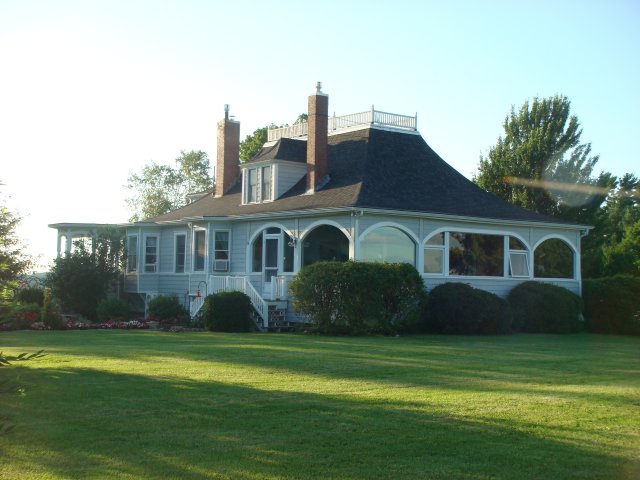
Set 2 of the
Flume Gorge in Franconia Notch State Park
Bob Jensen at
Trinity University
Son Marshall visited in July 2012.
On one of his days visiting with us he and I hiked in the Flume Gorge in
Franconia Notch State Park between Cannon Mountain and Mt. Lafayette
The Flume is only about 15 minutes from our cottage
Franconia Notch State Park ---
http://www.nhstateparks.org/explore/state-parks/franconia-notch-state-park.aspx
Flume Gorge ---
http://nhstateparks.org/explore/state-parks/flume-gorge.aspx
The Flume is a natural gorge extending 800 feet at the base of Mount Liberty. The walls of Conway granite rise to a height of 70 to 90 feet and are 12 to 20 feet apart. A trip into the Flume begins and ends at the Flume Visitor's Center. Guests can choose to walk through just the Gorge or do a two mile loop. The walk includes uphill walking and lots of stairs. The boardwalk allows you to look closely at the growth of flowers, ferns and mosses found here.
Framed by a spectacular vista of Mount Liberty and Mount Flume, the Visitor Center houses the Flume ticket office, information center, cafeteria, gift shop, and the state park system's historic Concord Coach. A 20-minute movie showcasing beautiful Franconia Notch State Park is available for viewing. Flume Gorge Logo
The Flume was discovered in 1808 by 93-year-old “Aunt” Jess Guernsey when she accidently came upon it while fishing. She had trouble convincing her family of the marvelous discovery, but eventually persuaded others to come and see for themselves. At that time, a huge egg-shaped boulder hung suspended between the walls. The rock was 10 feet (3m) high and 12 feet (3.6m) long. A heavy rainstorm in June of 1883 started a landslide that swept the boulder from its place. It has never been found. The same storm deepened the gorge and formed Avalanche Falls.
Jensen Comment
Marshall and I commenced this hike with the very short bus ride to the start of
the Flume. The most impressive part of the this gorge is the way the water
quickly flows across a bed of granite. The clear water sometimes only flows very
quickly and at other time is drops in water falls. The water, of course, is what
cut out this gorge in granite rock over millions of years. Recall that New
Hampshire is called "The Granite State."
Our Cottage in the Summer of 2012

Marshall captured this picture of one of our many hummingbirds.
These creatures flutter about my head while I tend to my flower gardens.
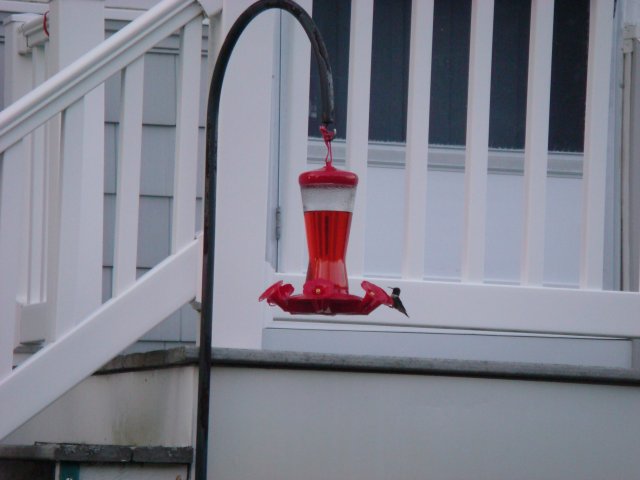
View from our cottage of the north end of Franconia Notch
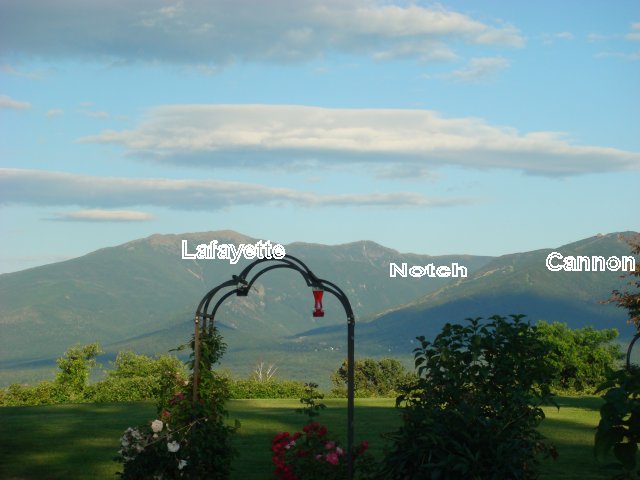
This is a zoomed picture from our yard showing the road north of Franconia Notch
At night we can see headlights moving like tiny dots in this clearing

Marshall took most of the pictures below
The Flume Gorge trail has hundreds of stair steps to make climbing easier
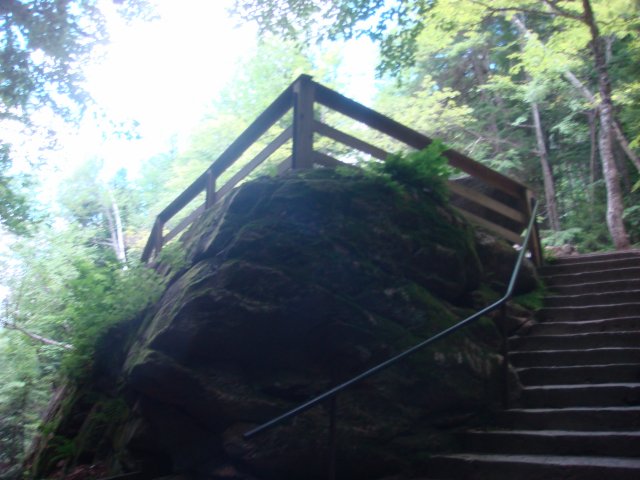
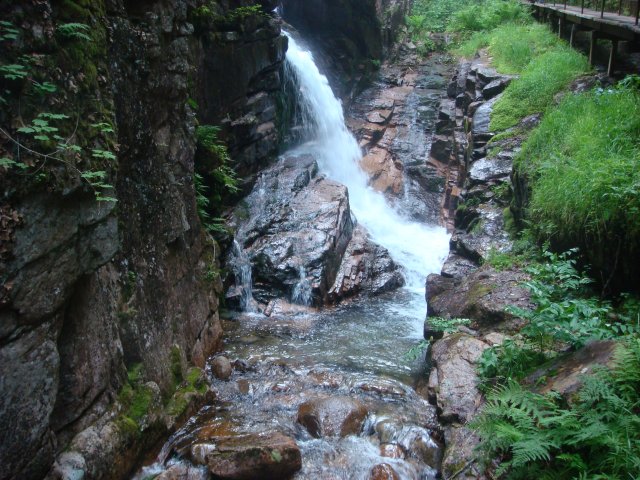
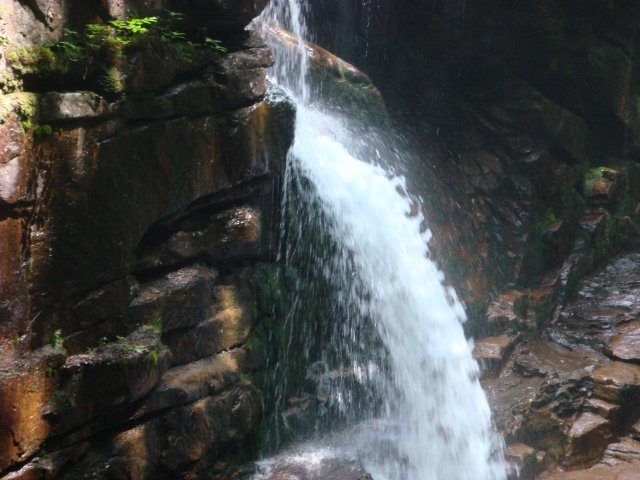

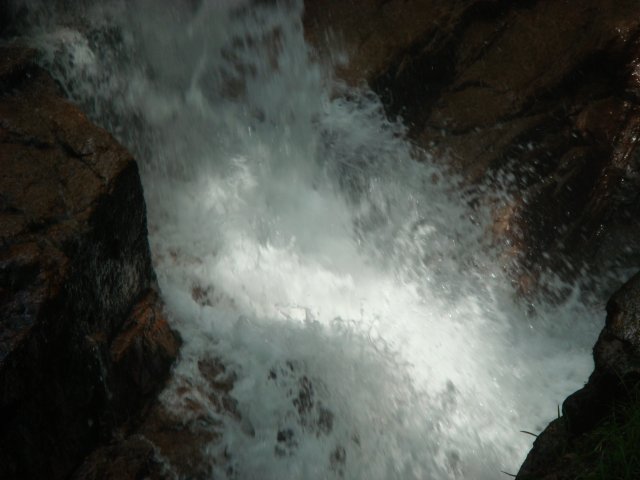
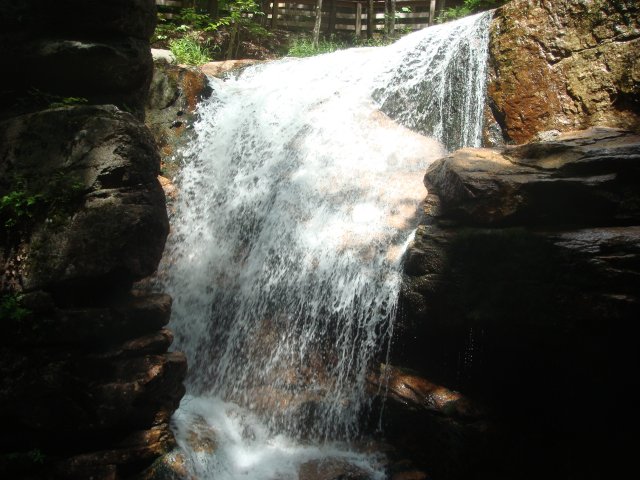
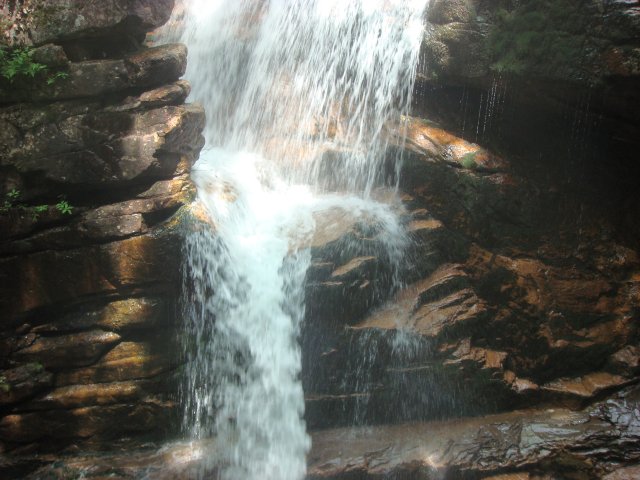
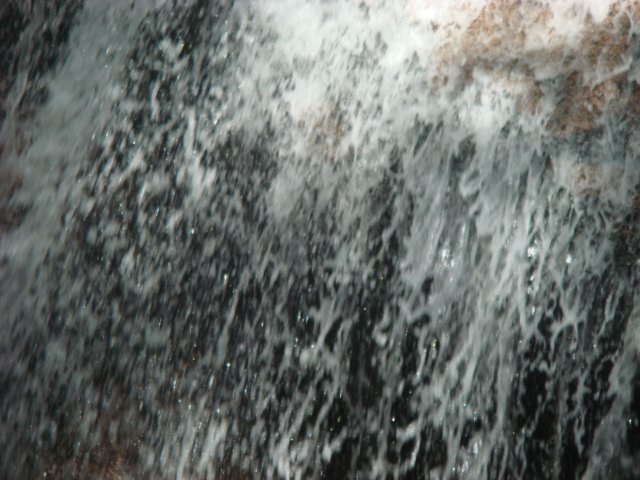
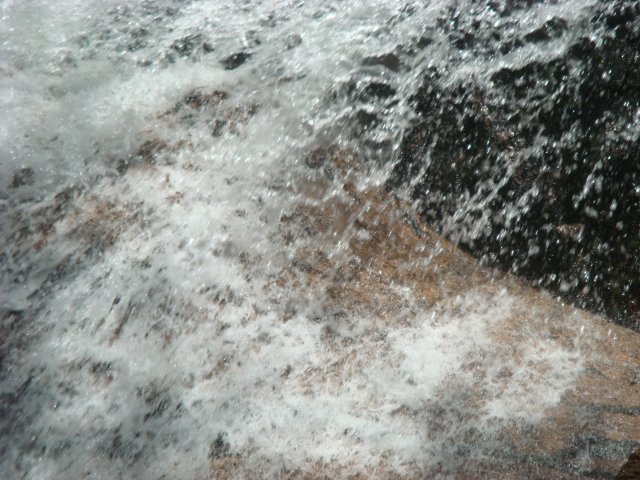
There is a small cave along the trail.
This is son Marshall in the cave
Marshall works in the Sterile Supply Department in the Lewiston, Maine Hospital
He's never been married (at least not yet)


Every time I take a guest to the Flume
I make them stand in this particular spot for a humor shot
Several years ago when Grandson Jonathon (from Wisconsin) visited I took his
picture in the same spot
During Marshall's visit we also went up to the Rim Trail on Cannon Mountain
In an future photograph set I will feature photos from that adventure

We also took the Cog Railroad to the Top of Mt. Washington
In an future photograph set I will feature photos from that adventure
The most famous lengthy hiking trails in Northern New England:
Northern Part of the Appalachian Trail ---
http://en.wikipedia.org/wiki/Appalachian_Trail
Portion of the Appalachian Trail in New Hampshire --- http://en.wikipedia.org/wiki/Appalachian_Trail_by_state#New_HampshireNew Hampshire has 161 miles (259 km) of the trail. The New Hampshire AT is nearly all within the White Mountain National Forest. The easier southern portion of the trail, from Hanover to Glencliff, passes over Velvet Rocks, Moose Mountain, Smarts Mountain, and Mount Cube. It then ascends Mount Moosilauke and enters the high peaks region of the Whites. For northbound thru-hikers, it is the beginning of the main challenges that go beyond enduring distance and time: in New Hampshire and Maine, rough or steep ground are more frequent, and alpine conditions are found near summits and along ridges.
The trail runs completely above tree line from the summit of Mount Pierce to the north side of the cone of Mt. Madison, a distance of about 12 miles (19 km). The AT passes over the summits of 16 of the 48 four-thousand footers of New Hampshire: Moosilauke, South and North Kinsman, Lincoln, Lafayette, Garfield, South Twin, Jackson, Pierce, Washington (the highest point of the AT north of Tennessee), Madison, Wildcats D and A, Carter Dome, South and Middle Carter. It comes close to the summits of 8 other of the 48 four-thousand footers: Liberty, Galehead, Zealand, Eisenhower, Monroe, Jefferson, Adams, and Moriah. A series of comfortable huts is maintained along parts of the NH trail by the Appalachian Mountain Club. In New Hampshire, the Dartmouth Outing Club maintains the AT from the Vermont border to Mount Moosilauke, with the AMC maintaining the remaining miles through the state. The trail passes through the towns of Hanover and Gorham, which have grocery stores and are accessible by public transportation (Dartmouth Coach and Concord Trailways) from Boston. Concord Trailways also has bus service to Lincoln (several miles off the AT) and AMC Pinkham Notch. During the summer season, AMC runs a shuttle service to Crawford Notch and Franconia Notch.
A tradition of thru-hikers Mooning the Cog has developed on Mount Washington.[
Portion of the Appalachian Trail in Maine --- http://en.wikipedia.org/wiki/Appalachian_Trail_by_state#Maine
The Long Trail that traverses Vermont from north to south ---
http://en.wikipedia.org/wiki/Long_Trail
Also see the photographs at http://guthook.blogspot.com/2012/07/a-long-trail-primer.html
There are over 600 hiking trails in the White Mountains (in multiple mountain
ranges) to the east of our cottage
Blogs of White
Mountain Hikers (many great photographs) ---
http://www.blogger.com/profile/02242409292439585691

Our Cottage's History
Sunset Hill Hotel Resort History Set 01 ---
http://www.trinity.edu/rjensen/tidbits/CottageHistory/Hotel/Brochure/Brochure1900.htmAfter the Sunset Hill Hotel Resort was nearly all demolished in 1973, our cottage (before it was ours)
was moved in 1977 from the golf course across a tennis court and up to where the former hotel site.
I show pictures of the preparation work prior to the moving the cottage and its four fireplaces
http://www.trinity.edu/rjensen/Tidbits/CottageHistory/OldSite/Set01/Set01.htmNext I show pictures of the move to the new site
http://www.trinity.edu/rjensen/Tidbits/CottageHistory/NewSite/Set01/Set01.htmNext I show the pictures of a 1980 spectacular fire on one of the remaining three cottages
www.trinity.edu/rjensen/tidbits/CottageHistory/Fire/FireSet01.htm
More of Bob Jensen's Pictures and
Stories
http://www.trinity.edu/rjensen/Pictures.htm
WhiteMountainHistory.org ---
http://whitemountainhistory.org/
Over 70 Historical Photographs ---
http://photos.whitemountainhistory.org/AlbumHomeView.aspx
Blogs of White
Mountain Hikers (many great photographs) ---
http://www.blogger.com/profile/02242409292439585691
Especially note
the archive of John Compton's blogs at the bottom of the page at
http://1happyhiker.blogspot.com/
Question
Are their trails in our White Mountains of New Hampshire that have ice in summer
as well as winter?
See "The Ice Gulch, Would I do it Again" by John Compton, August 5, 2011 ---
http://1happyhiker.blogspot.com/2011_08_05_archive.html
Okay, you might ask, is there really ice in the Ice Gulch, even in August? Yes, there is! The next photo shows one small patch of ice. There were many larger patches, but they were at the bottom of some of those deep gaps that I mentioned above. I took some photos, but none of them really turned out, even with using a flash to illuminate these dark, dank, deep spots.
AMC White Mountain Guide: Hiking Trails in the White Mountain National
Forest ---
http://books.google.com/books/about/AMC_White_Mountain_Guide.html?id=V6-hFq6yHcAC
Find Hiking Trails --- http://www.traillink.com/?gclid=CPPLy8-wt7ECFYNx4AodR2QAsQ
On May 14,
2006 I retired from
Trinity University after a long and
wonderful career as an accounting professor in four universities. I was
generously granted "Emeritus" status by the Trustees of Trinity University. My
wife and I now live in a cottage in the White Mountains of New Hampshire ---
http://www.trinity.edu/rjensen/NHcottage/NHcottage.htm
Bob
Jensen's Blogs ---
http://www.trinity.edu/rjensen/JensenBlogs.htm
Current and past editions of my newsletter called New
Bookmarks ---
http://www.trinity.edu/rjensen/bookurl.htm
Current and past editions of my newsletter called
Tidbits ---
http://www.trinity.edu/rjensen/TidbitsDirectory.htm
Current and past editions of my newsletter called
Fraud Updates ---
http://www.trinity.edu/rjensen/FraudUpdates.htm
Bob Jensen's past presentations and lectures
---
http://www.trinity.edu/rjensen/resume.htm#Presentations
Our
address is 190 Sunset Hill Road, Sugar Hill, New Hampshire
Our cottage was known as the Brayton Cottage in the early 1900s
Sunset Hill is a ridge overlooking with
New Hampshire's White Mountains to the East
and Vermont's
Green Mountains to the West
Bob Jensen's Threads --- http://www.trinity.edu/rjensen/threads.htm
Bob Jensen's Home Page --- http://www.trinity.edu/rjensen/